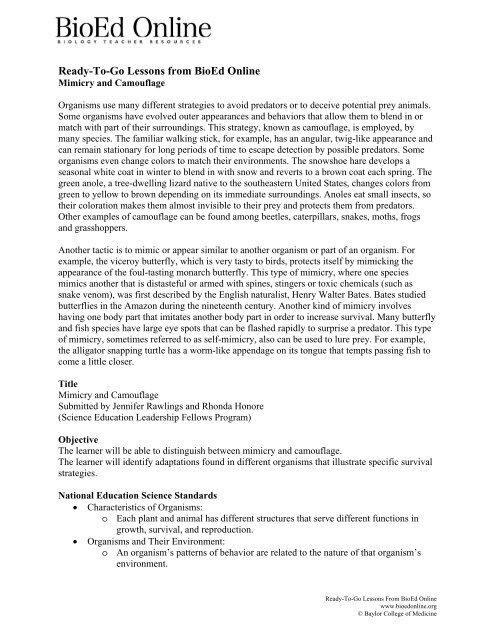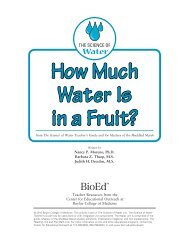Mimicry and Camouflage Lesson Plan - K8 Science
Mimicry and Camouflage Lesson Plan - K8 Science
Mimicry and Camouflage Lesson Plan - K8 Science
Create successful ePaper yourself
Turn your PDF publications into a flip-book with our unique Google optimized e-Paper software.
Ready-To-Go <strong>Lesson</strong>s from BioEd Online<strong>Mimicry</strong> <strong>and</strong> <strong>Camouflage</strong>Organisms use many different strategies to avoid predators or to deceive potential prey animals.Some organisms have evolved outer appearances <strong>and</strong> behaviors that allow them to blend in ormatch with part of their surroundings. This strategy, known as camouflage, is employed, bymany species. The familiar walking stick, for example, has an angular, twig-like appearance <strong>and</strong>can remain stationary for long periods of time to escape detection by possible predators. Someorganisms even change colors to match their environments. The snowshoe hare develops aseasonal white coat in winter to blend in with snow <strong>and</strong> reverts to a brown coat each spring. Thegreen anole, a tree-dwelling lizard native to the southeastern United States, changes colors fromgreen to yellow to brown depending on its immediate surroundings. Anoles eat small insects, sotheir coloration makes them almost invisible to their prey <strong>and</strong> protects them from predators.Other examples of camouflage can be found among beetles, caterpillars, snakes, moths, frogs<strong>and</strong> grasshoppers.Another tactic is to mimic or appear similar to another organism or part of an organism. Forexample, the viceroy butterfly, which is very tasty to birds, protects itself by mimicking theappearance of the foul-tasting monarch butterfly. This type of mimicry, where one speciesmimics another that is distasteful or armed with spines, stingers or toxic chemicals (such assnake venom), was first described by the English naturalist, Henry Walter Bates. Bates studiedbutterflies in the Amazon during the nineteenth century. Another kind of mimicry involveshaving one body part that imitates another body part in order to increase survival. Many butterfly<strong>and</strong> fish species have large eye spots that can be flashed rapidly to surprise a predator. This typeof mimicry, sometimes referred to as self-mimicry, also can be used to lure prey. For example,the alligator snapping turtle has a worm-like appendage on its tongue that tempts passing fish tocome a little closer.Title<strong>Mimicry</strong> <strong>and</strong> <strong>Camouflage</strong>Submitted by Jennifer Rawlings <strong>and</strong> Rhonda Honore(<strong>Science</strong> Education Leadership Fellows Program)ObjectiveThe learner will be able to distinguish between mimicry <strong>and</strong> camouflage.The learner will identify adaptations found in different organisms that illustrate specific survivalstrategies.National Education <strong>Science</strong> St<strong>and</strong>ards• Characteristics of Organisms:o Each plant <strong>and</strong> animal has different structures that serve different functions ingrowth, survival, <strong>and</strong> reproduction.• Organisms <strong>and</strong> Their Environment:o An organism’s patterns of behavior are related to the nature of that organism’senvironment.Ready-To-Go <strong>Lesson</strong>s From BioEd Onlinewww.bioedonline.org© Baylor College of Medicine
Audience/Time• Grades 2 -5• Two 45-minutes class periodsMaterials/Preparation1. Photographs of the monarch butterflyPhotographs of the viceroy butterflySee http://www.forestryimages.org/ , enter “butterfly” in search field2. Different photographs of various animals that use mimicry (see list below).Examples of <strong>Mimicry</strong> (see internet for images)Hawk moth caterpillar <strong>and</strong> snakesDrone fly <strong>and</strong> waspRed milk snake <strong>and</strong> coral snakeKing snake <strong>and</strong> coral snakeLonghorn beetle <strong>and</strong> antsViceroy butterfly <strong>and</strong> monarchOwl butterfly <strong>and</strong> eyes of a predator, such as an owlPacific gopher snake <strong>and</strong> rattlesnake3. Different photographs of various animals that use camouflage (see list below).Examples of <strong>Camouflage</strong> (see internet for images)Polar bear blends with snowy environmentCopperhead snake <strong>and</strong> fall leaves on groundWalking stick <strong>and</strong> branches of shrubs <strong>and</strong> treesLion <strong>and</strong> yellow-brown grassl<strong>and</strong>s of AfricaDark back of a fish <strong>and</strong> light underbelly (This is called countershading. As a predator looksdown into the water, with the light behind them, the water appears dark <strong>and</strong> the fishblends. Conversely, if the predator is looking up toward the surface, the water is lighter<strong>and</strong> the belly of the fish blends with the surroundings.)4. Nature News article, Jellyfish Capture Prey With Crimson Bait, found on BioEd online at:http://www.bioedonline.org/news/news.cfm?art=18885. Down load T-Chart PDF <strong>and</strong> make a transparency (or draw chart on the chalk board).<strong>Lesson</strong>Engage1. Give each group of four students a pair of photographs (one each of a viceroy <strong>and</strong>monarch butterfly; see http://www.naturalplanet.org/lessons/monarch-viceroy.htm).2. Have student groups discuss how the butterflies in the photographs are alike, <strong>and</strong> howthey are different.3. As a class, create a T-chart of similarities <strong>and</strong> differences between the two butterflies.Ready-To-Go <strong>Lesson</strong>s From BioEd Onlinewww.bioedonline.org© Baylor College of Medicine
(Note: A T-chart is a type of graphic organizer to help organize thoughts <strong>and</strong> showrelationships. In this case, it will show how a monarch butterfly <strong>and</strong> viceroy butterfly arealike, <strong>and</strong> how they are different.)4. Discuss the meaning of mimicry. Explain to students that butterflies are often eaten bybirds. The monarch is foul-tasting or poisonous to birds, while the viceroy is notpoisonous or foul-tasting. Ask students, Which butterfly is mimicking the other? Why?Explore1. Give each group of students photographs of animals that mimic another organism inorder to gain some type of advantage, or special help to survive in its environment.2. Ask each group to examine the photographs <strong>and</strong> decide:a) Is the animal mimicking another organism? If so, what organism? What is theadvantage?b) Does the animal possess a structure, coloration, or pattern that mimics anothertype of organism or part of an organism? If so, what is it? Why is it anadvantage to the organism?Explain1. Each group will share their group’s findings about one of the photographs they received.Discuss each one as a class <strong>and</strong> reach consensus on all the organisms in the photographs.2. Read or summarize the Nature News article, Jellyfish Capture Prey With Crimson Bait,found on BioEd Online: http://www.bioedonline.org/news/news.cfm?art=1888. Ask, Isthis article is describing a form of mimicry? (This article describes a jellyfish with atentacle that “mimics” a type of food for deep sea fish. The tentacle is used is to lure thefish close to the jellyfish so that it can capture the fish as its own food.) Discuss thisarticle as a class. Ask if any students can think of similar examples?Elaborate/Extend1. Review the meaning of mimicry with the class, <strong>and</strong> introduce or review the term,camouflage.2. Discuss how camouflage <strong>and</strong> mimicry are different, <strong>and</strong> how they are alike. For example,both camouflage <strong>and</strong> mimicry provide an advantage for an organism, <strong>and</strong> both involvethe organism copying either another organism or part of its environment. The primarydifference is that, with mimicry, an organism copies another organism or part of anorganism, while camouflage involves the copying of some part of the environment.3. Distribute (or have students locate <strong>and</strong> bring to class) pictures of animals that mimicother organisms <strong>and</strong> animals that use camouflage in their environments. Have studentscreate a T-chart showing which animals exhibit mimicry <strong>and</strong> which employ camouflage.4. Ask groups to share the information on their T-charts with the class <strong>and</strong> explain how theydecided which animals to put into each category.Ready-To-Go <strong>Lesson</strong>s From BioEd Onlinewww.bioedonline.org© Baylor College of Medicine
Going FurtherBased on students’ prior knowledge of animals, have them each create their own animal thatrelies on either camouflage or mimicry to ensure survival. Then have students present theiranimals to the class.Additional ReferencesBiodesign. Accessed 07-11-2006 at http://xnet.rrc.mb.ca/davidb/introduction2.htmMongaby.com. Tropical rainforest: rainforest diversity. Accessed 07-11-2006 athttp://rainforests.mongabay.com/0306.htmNational Teacher Training Institute. Hide in plain site. (Shows examples of katydid camouflage<strong>and</strong> hawk moth mimicry.) Accessed 07-11-2006 athttp://www.thirteen.org/edonline/ntti/resources/lessons/s_hide/index.htmlNature Works. Deceptive coloration. (Interesting explanation of disruptive colorationcamouflage, i.e. the zebra.) Accessed 07-11-2006 athttp://www.nhptv.org/natureworks/nwep2a.htmScholastic. Critter camouflage. Accessed 7/11/2006 athttp://teacher.scholastic.com/products/Instructor/Mar05_camouflage.htmWellington Zoo. <strong>Camouflage</strong>. Accessed 07-11-2006 athttp://www.wellingtonzoo.com/learn/teacher/camouflage.html<strong>Science</strong> Education Leadership Fellows ProgramFunded by the Howard Hughes Medical InstituteReady-To-Go <strong>Lesson</strong>s From BioEd Onlinewww.bioedonline.org© Baylor College of Medicine




